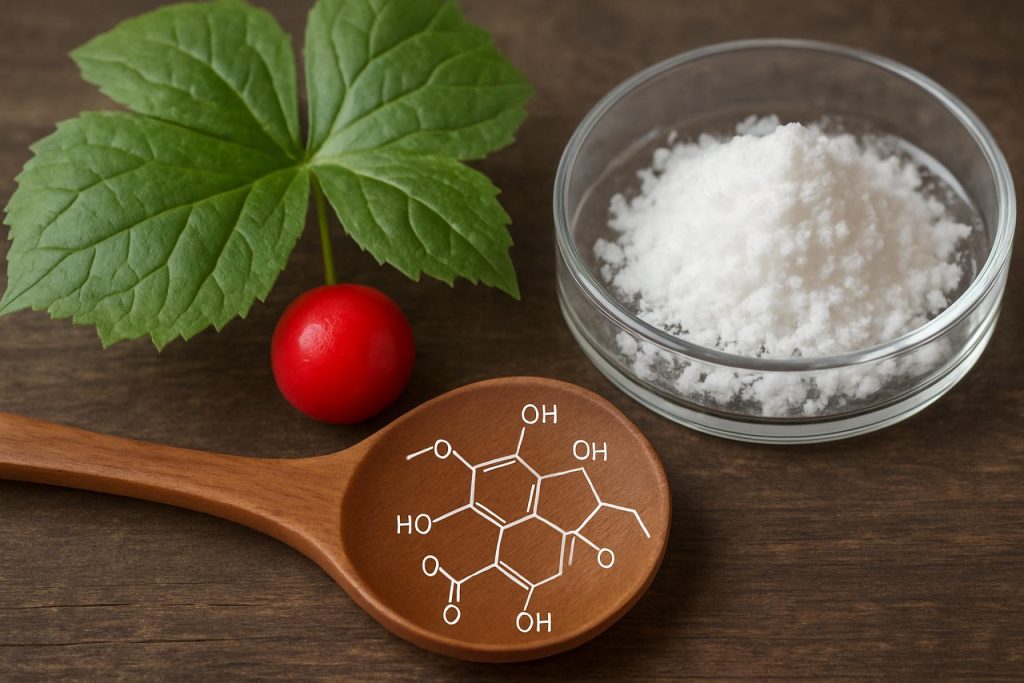
Unlocking the Power of Podophyllotoxin: How This Natural Lignan is Shaping the Future of Medicine. Discover Its Origins, Mechanisms, and Breakthrough Applications in Modern Healthcare. (2025)
- Introduction: What is Podophyllotoxin?
- Historical Discovery and Botanical Sources
- Chemical Structure and Mechanism of Action
- Current Medical Applications: Antiviral and Anticancer Uses
- Pharmaceutical Manufacturing and Regulatory Status
- Emerging Research: Novel Therapeutic Potentials
- Safety, Toxicity, and Side Effect Profile
- Market Trends and Global Demand Forecast (2024–2030)
- Technological Innovations in Extraction and Synthesis
- Future Outlook: Growth Projections and Public Interest
- Sources & References
Introduction: What is Podophyllotoxin?
Podophyllotoxin is a naturally occurring lignan compound primarily extracted from the roots and rhizomes of plants belonging to the genus Podophyllum, such as Podophyllum peltatum (American mayapple) and Podophyllum emodi (Himalayan mayapple). This compound is renowned for its potent biological activity, particularly its ability to inhibit cell division by interfering with microtubule assembly, making it a valuable precursor for several clinically important anticancer drugs. Podophyllotoxin itself is not typically used directly as a systemic therapeutic agent due to its toxicity, but its derivatives, such as etoposide and teniposide, are widely utilized in chemotherapy regimens for various malignancies, including lung cancer, testicular cancer, and lymphomas.
The molecular structure of podophyllotoxin is characterized by a polycyclic framework with multiple oxygenated functional groups, which contribute to its bioactivity. Its mechanism of action involves binding to tubulin, thereby preventing the formation of the mitotic spindle and arresting cells in the metaphase of the cell cycle. This property underpins its use in topical formulations for the treatment of benign epithelial lesions, such as genital warts caused by human papillomavirus (HPV). Podophyllotoxin-based topical medications are approved and recommended by health authorities for the management of external anogenital warts, reflecting its clinical significance in dermatology and sexual health.
The extraction and purification of podophyllotoxin from plant sources require careful processing, as the compound is present in relatively low concentrations and the raw plant material contains other lignans and potentially toxic substances. Advances in plant biotechnology and synthetic chemistry have enabled the development of semi-synthetic and fully synthetic routes to produce podophyllotoxin and its analogs, ensuring a more sustainable and controlled supply for pharmaceutical use. The World Health Organization (World Health Organization) recognizes podophyllotoxin as an essential medicine for the treatment of certain viral skin infections, underscoring its global health importance.
In summary, podophyllotoxin is a plant-derived compound with significant pharmacological applications, especially as a precursor for anticancer agents and as a topical antiviral treatment. Its discovery and subsequent development have had a profound impact on both oncology and dermatology, and ongoing research continues to explore new therapeutic uses and improved methods of production.
Historical Discovery and Botanical Sources
Podophyllotoxin is a naturally occurring lignan first isolated in the mid-19th century, with its discovery rooted in the traditional medicinal practices of indigenous peoples in North America and Asia. The compound was originally extracted from the rhizomes and roots of Podophyllum peltatum (American mayapple), a perennial herb native to the eastern United States and Canada. Native American tribes utilized preparations of this plant for a variety of therapeutic purposes, including as a purgative and for the treatment of warts and skin disorders. The medicinal value of the plant attracted the attention of early European settlers and botanists, leading to its formal scientific investigation in the 1800s.
The first chemical isolation of podophyllotoxin is credited to the work of German chemist Georg Dragendorff in 1880, who identified the active principle in the resin of Podophyllum species. Subsequent research throughout the late 19th and early 20th centuries elucidated the compound’s structure and pharmacological properties, establishing its role as a cytotoxic agent with significant potential in medicine. The botanical sources of podophyllotoxin are not limited to P. peltatum; the Himalayan species Podophyllum hexandrum (also known as Sinopodophyllum hexandrum or Indian mayapple) is another major source, particularly in Asia. This species is found in the subalpine and alpine regions of the Himalayas, including India, Nepal, and China, and has been used in traditional Ayurvedic and Chinese medicine for centuries.
Beyond the genus Podophyllum, podophyllotoxin and related lignans have also been identified in other plant families, such as Berberidaceae and Linaceae, though in much lower concentrations. The increasing demand for podophyllotoxin, especially as a precursor for the synthesis of anticancer drugs like etoposide and teniposide, has led to concerns about the overharvesting and conservation status of wild Podophyllum species. As a result, research efforts have expanded to include the cultivation of these plants and the exploration of alternative sources, including endophytic fungi capable of producing podophyllotoxin.
- The World Health Organization recognizes the historical and ongoing significance of medicinal plants, including those yielding podophyllotoxin, in traditional and modern healthcare systems.
- The Royal Botanic Gardens, Kew maintains extensive records on the taxonomy, distribution, and conservation status of Podophyllum species, highlighting their botanical and pharmacological importance.
Chemical Structure and Mechanism of Action
Podophyllotoxin is a naturally occurring aryltetralin lignan, primarily isolated from the roots and rhizomes of plants belonging to the genus Podophyllum, such as Podophyllum peltatum (American mayapple) and Podophyllum emodi (Himalayan mayapple). The chemical structure of podophyllotoxin is characterized by a polycyclic framework, specifically a trans-fused five-membered lactone ring attached to a four-ring system. Its molecular formula is C22H22O8, and the molecule contains several methoxy and hydroxyl functional groups, which are critical for its biological activity. The stereochemistry of podophyllotoxin is essential for its interaction with biological targets, and its configuration has been elucidated through X-ray crystallography and spectroscopic methods.
The mechanism of action of podophyllotoxin is primarily based on its ability to interfere with microtubule assembly. Podophyllotoxin binds to tubulin, the protein subunit of microtubules, at a site distinct from those targeted by other microtubule inhibitors such as colchicine or vinca alkaloids. This binding prevents the polymerization of tubulin into microtubules, thereby disrupting the mitotic spindle formation during cell division. As a result, cells are arrested in the metaphase stage of mitosis, leading to inhibition of cell proliferation and ultimately cell death. This antimitotic activity underpins the use of podophyllotoxin and its derivatives in the treatment of various proliferative disorders, including certain cancers and viral-induced warts.
Podophyllotoxin also serves as a precursor for the synthesis of several clinically important anticancer agents, most notably etoposide and teniposide. These semisynthetic derivatives act through a related but distinct mechanism: they inhibit the enzyme topoisomerase II, leading to DNA strand breaks and apoptosis in rapidly dividing cells. The development of these drugs highlights the significance of podophyllotoxin’s core structure in medicinal chemistry and oncology.
The World Health Organization (World Health Organization) recognizes podophyllotoxin as an essential medicine for the topical treatment of genital warts caused by human papillomavirus (HPV). Its inclusion in the WHO Model List of Essential Medicines underscores its clinical relevance and safety profile when used appropriately. Research into the structure-activity relationships of podophyllotoxin continues to inform the design of novel therapeutic agents with improved efficacy and reduced toxicity.
Current Medical Applications: Antiviral and Anticancer Uses
Podophyllotoxin is a naturally occurring lignan extracted primarily from the roots and rhizomes of plants such as Podophyllum peltatum (American mayapple) and Podophyllum hexandrum (Himalayan mayapple). Its unique mechanism of action—binding to tubulin and inhibiting microtubule assembly—has made it a valuable lead compound in both antiviral and anticancer therapies.
In antiviral medicine, podophyllotoxin is most notably used for the topical treatment of external anogenital warts (condylomata acuminata) caused by human papillomavirus (HPV). The compound induces necrosis of wart tissue by disrupting cell division, leading to the destruction of infected epithelial cells. Podophyllotoxin-based preparations, such as 0.5% topical solutions or gels, are recommended by major health authorities for patient-applied therapy, offering a non-invasive alternative to surgical or ablative procedures. The Centers for Disease Control and Prevention (CDC) and the World Health Organization (WHO) both list podophyllotoxin among the first-line treatments for genital warts, emphasizing its efficacy and safety profile when used as directed.
Beyond its direct antiviral effects, podophyllotoxin serves as the chemical precursor for the synthesis of several important anticancer agents. The most prominent derivatives are etoposide and teniposide, which are semi-synthetic glycosides used extensively in chemotherapy regimens. These drugs act by inhibiting topoisomerase II, an enzyme critical for DNA replication and cell division, thereby inducing apoptosis in rapidly proliferating cancer cells. Etoposide is a mainstay in the treatment of small cell lung cancer, testicular cancer, lymphomas, and certain leukemias, while teniposide is used for acute lymphoblastic leukemia and other malignancies. The National Cancer Institute (NCI) recognizes both agents as essential components of modern oncology protocols.
Ongoing research continues to explore new podophyllotoxin analogs with improved selectivity and reduced toxicity, as well as novel delivery systems to enhance therapeutic outcomes. The dual role of podophyllotoxin—as a direct antiviral and as a progenitor of potent chemotherapeutic agents—underscores its enduring significance in contemporary medicine. Its applications are supported by decades of clinical experience and endorsement from leading health organizations, ensuring its continued relevance in the management of viral and neoplastic diseases.
Pharmaceutical Manufacturing and Regulatory Status
Podophyllotoxin is a naturally occurring lignan extracted primarily from the roots and rhizomes of plants such as Podophyllum hexandrum and Podophyllum peltatum. It serves as a precursor for several semi-synthetic anticancer agents, most notably etoposide and teniposide, which are widely used in chemotherapy regimens. The pharmaceutical manufacturing of podophyllotoxin and its derivatives involves both extraction from plant sources and, increasingly, biotechnological synthesis to address sustainability and supply chain concerns.
The extraction process typically includes solvent extraction, purification, and crystallization steps to ensure pharmaceutical-grade purity. Advances in biotechnological methods, such as plant cell culture and microbial biosynthesis, are being explored to provide more consistent yields and reduce reliance on wild plant populations, which are under threat due to overharvesting. These innovations are supported by research institutions and pharmaceutical companies aiming to secure a stable supply of podophyllotoxin for drug manufacturing.
Podophyllotoxin itself is not used systemically due to its toxicity, but it is formulated for topical application in the treatment of conditions such as genital warts (caused by human papillomavirus) and molluscum contagiosum. The U.S. Food and Drug Administration (FDA) has approved podophyllotoxin-containing products for topical use, with strict guidelines regarding concentration and application to minimize adverse effects. The European Medicines Agency (EMA) also regulates podophyllotoxin-based pharmaceuticals, ensuring their safety, efficacy, and quality through rigorous assessment and post-market surveillance.
For anticancer applications, podophyllotoxin serves as the chemical backbone for the synthesis of etoposide and teniposide. These drugs are included in the World Health Organization’s Model List of Essential Medicines, reflecting their critical role in cancer therapy worldwide. Manufacturing of these derivatives is subject to Good Manufacturing Practice (GMP) standards, as enforced by regulatory authorities such as the U.S. Food and Drug Administration and the European Medicines Agency. These agencies oversee the entire lifecycle of podophyllotoxin-derived pharmaceuticals, from raw material sourcing to finished product release.
- The U.S. Food and Drug Administration is responsible for the approval and regulation of podophyllotoxin-containing drugs in the United States, ensuring their safety and efficacy.
- The European Medicines Agency performs a similar role in the European Union, with centralized procedures for the evaluation and monitoring of medicinal products.
- The World Health Organization includes podophyllotoxin derivatives in its essential medicines list, underscoring their global health importance.
In summary, the pharmaceutical manufacturing and regulatory status of podophyllotoxin is characterized by stringent quality controls, evolving production technologies, and robust oversight by major health authorities to ensure the safe and effective use of this critical pharmaceutical precursor.
Emerging Research: Novel Therapeutic Potentials
Podophyllotoxin, a naturally occurring lignan primarily extracted from the roots and rhizomes of Podophyllum species, has long been recognized for its potent cytotoxic properties and its foundational role in the development of anticancer agents such as etoposide and teniposide. In recent years, emerging research has expanded the therapeutic landscape of podophyllotoxin, revealing novel applications and mechanisms that may shape future clinical interventions.
One of the most promising areas of investigation is the development of new podophyllotoxin derivatives with enhanced selectivity and reduced toxicity. Structural modifications, particularly at the C-4 and C-7 positions of the podophyllotoxin molecule, have yielded analogs with improved pharmacological profiles. These derivatives are being evaluated for their efficacy against multidrug-resistant cancer cell lines, with some demonstrating the ability to overcome resistance mechanisms that limit the effectiveness of traditional chemotherapeutics. This line of research is supported by ongoing studies in academic and pharmaceutical laboratories worldwide, including those affiliated with the National Cancer Institute.
Beyond oncology, podophyllotoxin is being explored for its antiviral properties. Recent preclinical studies have indicated that podophyllotoxin and its analogs can inhibit the replication of viruses such as human papillomavirus (HPV) and herpes simplex virus (HSV), suggesting potential for the development of topical or systemic antiviral therapies. The World Health Organization has recognized the need for novel antiviral agents, particularly in the context of rising resistance to existing treatments, and podophyllotoxin-based compounds are being considered as candidates for further investigation.
Additionally, research is underway to harness the immunomodulatory effects of podophyllotoxin. Early findings suggest that certain derivatives may modulate immune cell activity, opening avenues for their use in autoimmune disorders or as adjuncts to immunotherapy in cancer. These studies are in the preclinical phase, but they highlight the compound’s multifaceted biological activity and its potential to address unmet medical needs.
The ongoing exploration of podophyllotoxin’s therapeutic potential is facilitated by advances in synthetic chemistry, biotechnology, and pharmacology. Collaborative efforts among research institutions, regulatory agencies, and organizations such as the U.S. Food and Drug Administration are critical in translating these discoveries into safe and effective therapies. As of 2025, the expanding body of evidence underscores podophyllotoxin’s status as a versatile lead compound in drug discovery, with the promise of novel treatments for cancer, viral infections, and immune-mediated diseases.
Safety, Toxicity, and Side Effect Profile
Podophyllotoxin is a naturally occurring lignan extracted primarily from the roots and rhizomes of plants such as Podophyllum peltatum and Podophyllum emodi. It is widely used as the active ingredient in topical medications for the treatment of external genital warts and molluscum contagiosum. While podophyllotoxin is effective, its safety, toxicity, and side effect profile require careful consideration due to its potent cytotoxic properties.
Topical application of podophyllotoxin is generally considered safe when used as directed, with the U.S. Food and Drug Administration (U.S. Food and Drug Administration) approving its use in specific concentrations (typically 0.5% solution or gel) for external anogenital warts. However, improper use or application to large surface areas can result in significant local and systemic toxicity. The most common adverse effects are localized and include erythema, burning, pain, pruritus, and ulceration at the site of application. These reactions are usually mild to moderate and resolve upon discontinuation of therapy.
Systemic toxicity is rare with topical use but can occur if the drug is applied to broken skin, large areas, or ingested. Symptoms of systemic toxicity may include nausea, vomiting, diarrhea, confusion, bone marrow suppression, and in severe cases, multi-organ failure. Podophyllotoxin is highly toxic if ingested, and oral exposure can be fatal. For this reason, podophyllotoxin and its crude plant extracts are not recommended for internal use, and their use is contraindicated in pregnant or breastfeeding women due to potential teratogenic and embryotoxic effects, as highlighted by the World Health Organization.
Podophyllotoxin’s mechanism of action involves inhibition of microtubule assembly, leading to cell cycle arrest and apoptosis in rapidly dividing cells. This underlies both its therapeutic efficacy and its potential for toxicity. The European Medicines Agency and other regulatory authorities emphasize the importance of limiting podophyllotoxin use to external lesions and following strict dosing guidelines to minimize adverse effects.
- Local side effects: erythema, pain, burning, pruritus, ulceration
- Systemic toxicity (rare): gastrointestinal symptoms, neurotoxicity, bone marrow suppression
- Contraindications: pregnancy, breastfeeding, application to mucous membranes or large/broken skin areas
In summary, podophyllotoxin is a potent topical agent with a well-characterized safety and toxicity profile. Adherence to recommended usage guidelines and awareness of contraindications are essential to minimize risks and ensure patient safety.
Market Trends and Global Demand Forecast (2024–2030)
The global market for podophyllotoxin, a naturally derived lignan primarily used as a precursor for anticancer drugs and topical treatments for viral infections, is experiencing notable shifts in demand and supply dynamics from 2024 to 2030. Podophyllotoxin’s primary application remains in the synthesis of semi-synthetic derivatives such as etoposide and teniposide, which are essential chemotherapeutic agents for various cancers, including lung and testicular cancers. Additionally, podophyllotoxin is widely utilized in dermatology for the treatment of genital warts and other skin conditions.
A key trend shaping the market is the increasing global incidence of cancer, which continues to drive demand for podophyllotoxin-based pharmaceuticals. According to the World Health Organization, cancer remains a leading cause of morbidity and mortality worldwide, with the number of new cases projected to rise significantly over the coming decade. This epidemiological trend is expected to sustain and potentially accelerate the demand for podophyllotoxin derivatives, especially in emerging economies where access to advanced cancer therapies is expanding.
Another significant factor influencing the market is the ongoing shift from wild harvesting of Podophyllum species to more sustainable and controlled cultivation practices. Overharvesting of natural sources, particularly Podophyllum hexandrum and Podophyllum peltatum, has led to concerns about biodiversity and supply chain stability. In response, several pharmaceutical companies and research institutions are investing in biotechnological methods, such as plant cell culture and microbial synthesis, to ensure a reliable and eco-friendly supply of podophyllotoxin. Organizations like the Food and Agriculture Organization of the United Nations have highlighted the importance of sustainable sourcing for medicinal plants, which is likely to influence regulatory frameworks and industry practices through 2030.
Regionally, Asia-Pacific is anticipated to witness the fastest growth in podophyllotoxin demand, driven by expanding pharmaceutical manufacturing capabilities in countries such as India and China. North America and Europe continue to represent mature markets, with steady demand supported by established healthcare infrastructure and ongoing research into novel podophyllotoxin derivatives.
Looking ahead to 2030, the podophyllotoxin market is expected to benefit from advancements in extraction technologies, increased investment in cancer therapeutics, and a growing emphasis on sustainable sourcing. However, market growth may be tempered by regulatory challenges related to the conservation of endangered plant species and the need for rigorous quality control in pharmaceutical production. Overall, the outlook remains positive, with global demand projected to rise in tandem with the broader trends in oncology and dermatology therapeutics.
Technological Innovations in Extraction and Synthesis
Podophyllotoxin, a naturally occurring lignan primarily sourced from the roots and rhizomes of Podophyllum species, is a critical precursor for several clinically important anticancer drugs, such as etoposide and teniposide. Traditional extraction methods have relied on wild harvesting, raising sustainability and supply concerns. In recent years, technological innovations have transformed both the extraction and synthesis of podophyllotoxin, aiming to improve yield, purity, and environmental impact.
One significant advancement is the adoption of supercritical fluid extraction (SFE) using carbon dioxide. This method offers a greener alternative to conventional organic solvent extraction, reducing toxic residues and improving selectivity for podophyllotoxin. SFE operates under controlled temperature and pressure, which preserves the integrity of thermolabile compounds and enhances extraction efficiency. Additionally, ultrasound-assisted extraction (UAE) and microwave-assisted extraction (MAE) have been developed to further increase yield and reduce processing time, leveraging physical energy to disrupt plant cell walls and facilitate compound release.
Biotechnological approaches are also gaining traction. Plant cell culture technology enables the production of podophyllotoxin in controlled environments, independent of geographical and climatic constraints. This method not only ensures a consistent supply but also allows for metabolic engineering to enhance podophyllotoxin biosynthesis. Researchers have successfully established in vitro cultures of Podophyllum hexandrum and related species, optimizing media and elicitor conditions to maximize yields. Furthermore, hairy root cultures induced by Agrobacterium rhizogenes have demonstrated high productivity and genetic stability, making them promising platforms for commercial-scale production.
On the synthetic front, advances in chemoenzymatic synthesis have enabled the semi-synthesis of podophyllotoxin and its analogs from simpler, more readily available precursors. Enzyme-catalyzed steps offer regio- and stereoselectivity, reducing the need for harsh chemicals and minimizing byproducts. This approach is particularly valuable for producing derivatives with improved pharmacological profiles.
These technological innovations are supported and monitored by organizations such as the U.S. Food and Drug Administration and the European Medicines Agency, which oversee the quality and safety of pharmaceutical ingredients. Additionally, research institutions and botanical gardens worldwide are collaborating to develop sustainable cultivation and extraction protocols, ensuring the long-term availability of podophyllotoxin for medicinal use.
Future Outlook: Growth Projections and Public Interest
The future outlook for podophyllotoxin, a naturally occurring lignan with potent antimitotic and antiviral properties, is shaped by ongoing research, evolving therapeutic needs, and increasing public awareness of plant-derived pharmaceuticals. As of 2025, the global demand for podophyllotoxin is expected to rise, driven by its critical role as a precursor in the synthesis of clinically important anticancer drugs such as etoposide and teniposide. These drugs are included in the World Health Organization’s Model List of Essential Medicines, underscoring the compound’s medical significance (World Health Organization).
Growth projections for podophyllotoxin are closely linked to advances in oncology and dermatology. The compound’s established use in topical treatments for conditions like genital warts, as well as its ongoing evaluation in novel antiviral and anticancer therapies, suggest a robust pipeline of research and development. Pharmaceutical companies and academic institutions are actively exploring biotechnological methods to produce podophyllotoxin sustainably, including plant cell culture and microbial synthesis, to address concerns over the overharvesting of natural sources such as Podophyllum hexandrum and Podophyllum peltatum (U.S. Food and Drug Administration).
Public interest in podophyllotoxin is also expected to grow, reflecting broader trends in favor of natural and plant-based medicines. Increased awareness of the ecological impact of wild harvesting has prompted calls for sustainable sourcing and conservation efforts, with organizations such as the Convention on International Trade in Endangered Species of Wild Fauna and Flora (CITES) monitoring trade in podophyllum species. This regulatory oversight is likely to influence both supply chains and research priorities in the coming years.
Looking ahead, the integration of podophyllotoxin into new drug formulations, coupled with advances in synthetic biology, may expand its therapeutic applications and market reach. The continued collaboration between regulatory agencies, conservation bodies, and the pharmaceutical industry will be essential to ensure both the availability and sustainability of podophyllotoxin-derived products. As research progresses and public interest intensifies, podophyllotoxin is poised to remain a focal point in the intersection of natural product chemistry, medicine, and environmental stewardship.
Sources & References
- World Health Organization
- Royal Botanic Gardens, Kew
- Centers for Disease Control and Prevention
- National Cancer Institute
- European Medicines Agency
- Food and Agriculture Organization of the United Nations



